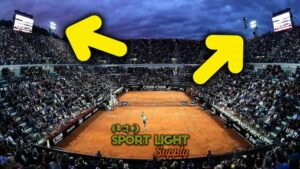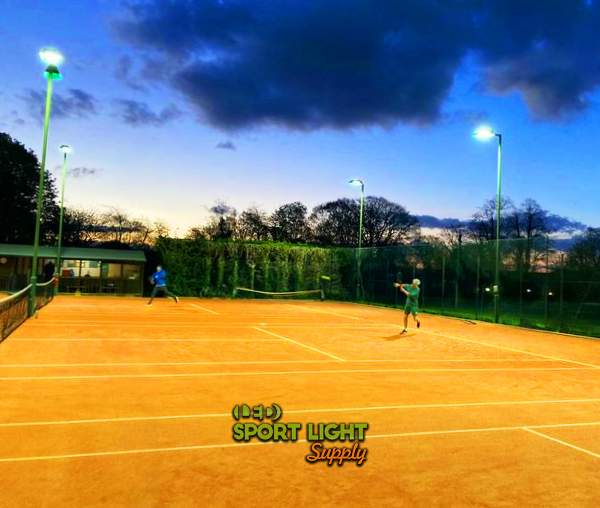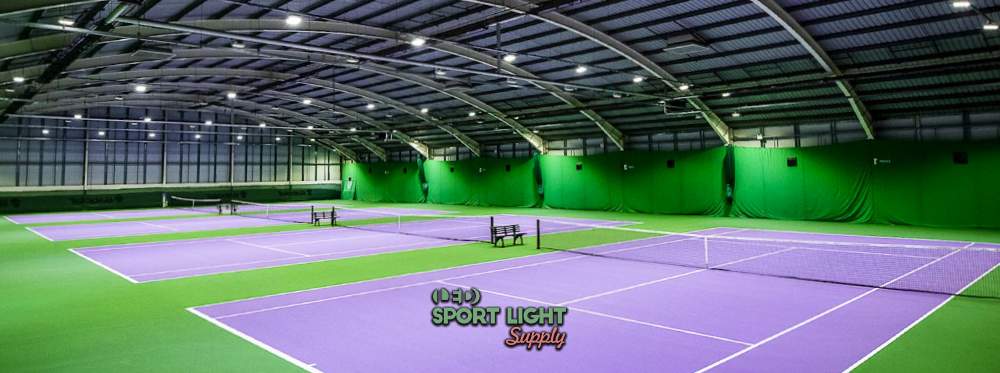
A well-lit court provides uniform visibility, enabling players to focus on every serve, spin, and volley without distraction, while also enhancing the clarity for officials and fans. From lux levels tailored for recreational versus professional courts to strategic fixture placement and glare reduction, each lighting element supports a cohesive playing environment.
Table of Contents
ToggleThe brightness level on a tennis court is foundational to providing an optimal environment for players and spectators alike. Proper lighting ensures every corner of the playing area is illuminated without harsh shadows that could distort perceptions and impact players’ performance.
 For recreational courts, the recommended brightness level, or illuminance, typically hovers around 300 lux, creating a comfortable environment for casual play. For professional settings and competitions, however, higher illuminance levels between 500 and 1,000 lux are generally advisable to allow players and spectators to see each movement with clarity. Whether observing a high-speed serve or following a rapid return, the consistent brightness ensures each detail is visible, enhancing the overall playing experience.
For recreational courts, the recommended brightness level, or illuminance, typically hovers around 300 lux, creating a comfortable environment for casual play. For professional settings and competitions, however, higher illuminance levels between 500 and 1,000 lux are generally advisable to allow players and spectators to see each movement with clarity. Whether observing a high-speed serve or following a rapid return, the consistent brightness ensures each detail is visible, enhancing the overall playing experience.
Adequate brightness not only affects players’ ability to react to the game but also enhances visibility for onlookers and officials, who need clear views to make accurate assessments. A court with an appropriate brightness level allows for better visual engagement, ensuring that every shot, spin, and volley is distinctly perceptible. High-quality lighting, especially in competitive environments, is a cornerstone of fair play, enabling all participants to perform at their peak.
Uniform lighting is key to creating a balanced visual field for players, as fluctuations in brightness across the court can disrupt a player’s ability to track the ball. Lighting uniformity refers to how evenly light is distributed, and achieving a ratio of 0.6 to 0.7 is ideal for most courts.
With this level of uniformity, there are no dark spots or overly bright areas that could distract players or interfere with their perception of the ball’s speed and trajectory. Consistency in light distribution helps maintain visual comfort, particularly during fast-paced exchanges, where tracking the ball’s flight is crucial. Without a uniform lighting arrangement, players may struggle with fluctuating visibility, potentially missing the ball or misjudging shots due to sudden shifts in brightness.
Uniformity is not just a technical specification but an aspect of lighting that deeply influences the quality and fluidity of gameplay. For tennis enthusiasts, maintaining even lighting across the court supports an uninterrupted experience, allowing both players and spectators to stay focused on the game itself rather than on adjusting to uneven light conditions.
The color temperature of tennis court lighting significantly impacts both the visual appeal and comfort of the space. Recommended color temperatures for court lighting generally fall between 4000K and 6500K, as this range closely resembles natural daylight.
Such daylight-mimicking illumination allows players to see the ball, net, and lines clearly without straining their eyes, even during high-intensity rallies. Color temperature directly influences how objects on the court are perceived. A warmer light below 4000K can make the court appear dim and less vivid, whereas a color temperature over 6500K can create a stark, almost clinical feel that may lead to visual discomfort during extended matches.
By selecting lighting within the 4000K to 6500K range, facilities can ensure that players are operating in a naturally illuminated space, which enhances concentration and reaction time. For spectators, a court lit with the correct color temperature is more visually pleasing, as the true colors of the court and players’ attire are clearly visible.

Glare reduction is a crucial aspect of tennis court lighting design, as excessive glare can disrupt players’ focus and cause discomfort. Glare is often produced when light fixtures are too bright or poorly positioned, resulting in harsh reflections that can distract players and impair visibility.
Effective glare control involves strategic fixture positioning and the use of anti-glare technology, which may include fixtures with specialized shields or lenses. Minimizing glare helps players maintain a clear line of sight throughout the game, free from visual distractions that could affect performance. Reduced glare is especially valuable in outdoor settings, where natural light variations, such as sunlight or reflections from surrounding surfaces, can compound glare issues.
By managing both natural and artificial light sources, court designers can create an environment where players remain focused, with minimal visual interference. Fixtures designed with glare control in mind enhance the overall playing experience, allowing athletes to concentrate solely on the game.
The strategic placement of lighting fixtures plays a significant role in achieving optimal court illumination. Typically, fixtures are mounted at the corners and along the sides of the court, positioned at heights and angles that provide even coverage across the playing area without casting intrusive shadows.
These carefully selected locations prevent light from spilling into surrounding areas, ensuring that the court remains the primary focus. Proper fixture placement not only promotes even lighting but also enhances safety. Light poles positioned along the perimeter reduce the risk of shadows falling across crucial areas, such as the net or baseline, where clear visibility is most needed.
For indoor courts, the placement of ceiling-mounted fixtures can be configured to minimize light loss and prevent fixtures from interfering with play. Outdoor courts often require additional considerations, such as the surrounding landscape, to avoid spillage into neighboring areas. When lighting is positioned thoughtfully, players benefit from unobstructed views and a well-lit court that enhances their ability to respond quickly.
Energy efficiency is a key consideration in modern court lighting, especially as facilities aim to reduce operational costs and environmental impact. LED lighting solutions have become popular for their energy-efficient properties, as they consume significantly less electricity compared to traditional lighting technologies.
LEDs offer a high luminous efficacy, meaning they produce more light per watt, which allows for excellent brightness while keeping energy consumption low. The advantages of LED lighting extend beyond energy savings. LEDs also have a much longer lifespan than traditional lighting options, reducing the frequency of replacements and maintenance needs. This durability minimizes disruptions to scheduled games, as courts can remain well-lit for extended periods without the need for frequent intervention.
Additionally, by choosing energy-efficient lighting, facilities reduce their carbon footprint, contributing to environmental conservation while maintaining excellent illumination standards. In this way, modern LED lighting solutions support sustainability without compromising the quality of light on the court.
Tennis court lighting must be built to endure diverse environmental conditions, especially in outdoor settings where fixtures may be exposed to rain, wind, and intense sunlight. Choosing durable, weather-resistant fixtures is fundamental to ensuring long-term performance.
High-quality materials such as corrosion-resistant metals and UV-stabilized coatings are commonly used in outdoor fixtures to withstand various weather elements. Regular maintenance is also vital to keep the lighting system operating at peak performance. Maintenance tasks, such as cleaning lenses, checking for loose connections, and replacing faulty components, ensure that fixtures continue to deliver consistent brightness and uniformity.
LED lighting, due to its extended lifespan, further reduces maintenance demands compared to traditional lighting technologies. LEDs are known for their durability and resilience, making them a reliable choice for both indoor and outdoor courts. With fewer replacement cycles and reduced risk of wear and tear, LED lighting solutions support a consistently well-lit environment that can withstand varying conditions, providing reliable performance year-round.
Strategic fixture placement ensures even illumination across the court, while energy-efficient LED technology supports sustainability and lowers costs. Durability and regular maintenance further guarantee consistent lighting quality, allowing both recreational and professional players to perform at their best in any setting. By prioritizing these elements, courts can offer a well-lit, comfortable environment that enhances every aspect of the game.
Drop us a line to receive a free lighting design